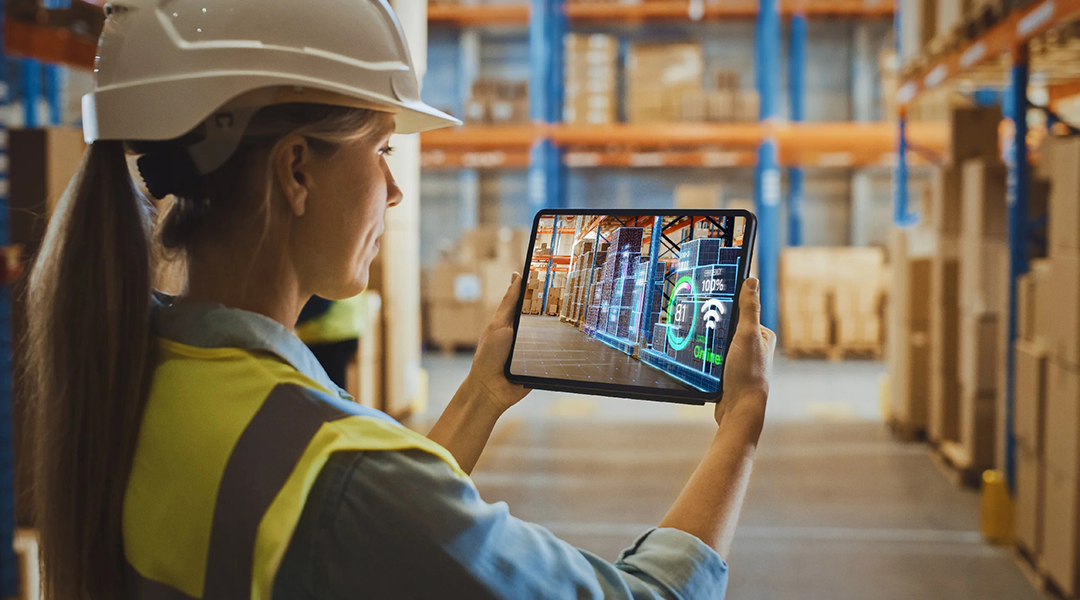Augmented reality (AR) is often misunderstood by the general public, who commonly perceive it merely as an entertainment tool for rendering three-dimensional visuals within a camera's viewfinder. However, the capabilities and applications of augmented reality extend far beyond brief amusement. In the current era, businesses can leverage AR to transform their operations and customer interactions profoundly.
Since its inception in 1992, when the first operational AR system was introduced, the technology has advanced significantly while retaining its core functionality. Users of augmented reality continue to interact with their physical environment, but the technology superimposes additional digital and virtual elements onto their real-world view through devices such as smartphones and AR glasses.
There are several distinct AR types, each with specific functionalities and applications:
(feel free to use the links to jump to the type you want to read about)
Each category within these types of augmented reality offers unique benefits and is suited for different use cases, which merit further exploration. Businesses interested in integrating AR can consider how these types of AR can enhance their services or customer engagement. Those looking to build an AR app may find that understanding the specific advantages of each type provides valuable insights. Alternatively, companies might explore augmented reality app development services to implement this technology effectively.
As augmented reality continues to evolve, its utility in various sectors becomes increasingly apparent, making it a worthwhile consideration for forward-thinking enterprises.
What Is Augmented Reality?
Augmented reality enhances the real world by overlaying digital information directly onto it. Users see and interact with their environment, augmented by computer-generated images, sounds, or other data, typically through a device like a smartphone or specialized AR glasses. Augmented reality differs from virtual reality in that it does not replace the real world with a digital one but rather meaningfully adds to the existing environment.
In today's technological landscape, various types of augmented reality serve diverse applications, from gaming and education to retail and industrial maintenance. Each type uses distinct mechanisms to engage with users and deliver content. For example, marker-based AR activates digital overlays when a device's camera identifies a specific visual trigger, such as a QR code, while markerless AR uses sophisticated algorithms to place digital objects in physical spaces without needing predefined markers.
Location-based AR offers another approach by using the geographic location of a device to trigger relevant content, enhancing users' interaction with their surroundings based on where they are. Moreover, businesses are finding innovative uses for these types of augmented reality, applying them to enhance customer experiences, improve training procedures, and even augment shopping experiences.
Understanding the different types of augmented reality and their capabilities can help developers and businesses tailor their AR applications to meet user needs and expectations better. As augmented reality continues to grow, its integration into everyday life seems increasingly inevitable, offering new ways for people to interact with the world around them.
Types of Mobile Augmented Reality
Mobile augmented reality, leveraging the portability of smartphones and tablets, has democratized access to AR experiences, allowing a broad audience to interact with enhanced real-world views. Various types of mobile augmented reality cater to different applications and user experiences.
Marker-based AR. When the camera on a mobile device detects a specific image or symbol, digital content is triggered and displayed. Commonly used in advertising and educational materials, this type of augmented reality provides a straightforward way for users to access interactive content through everyday items like product packaging or printed media.
Markerless AR. This form does not rely on predetermined markers. Instead, it uses the device's sensors to detect the position and orientation of the surface in real time, allowing digital objects to be placed freely in the environment. It is widely used in interior design and furniture apps, where users can visualize how new items might look in their own space.
Location-based AR. By utilizing the GPS, compass, and other location data from a mobile device, augmented reality content is activated based on the user's geographical location. Applications include navigation aids, where street names and directions can be overlaid directly onto the live view of a street, and gaming, where virtual objects are placed in real-world locations.
Understanding the distinct types of mobile augmented reality can empower developers to create more tailored and engaging AR applications, ensuring that users receive relevant and immersive experiences tailored to their immediate context. Each type provides unique possibilities, enhancing how augmented reality can be integrated into daily activities.
What is Marker-Based Augmented Reality?
Marker-based AR, a key category within the types of augmented reality, operates primarily through the use of image recognition technology. Essentially, this approach involves an application using a mobile device's camera to continuously capture video, which it then analyzes to identify specific images known as markers. These markers are predefined images integrated into the physical environment, which could be anything from a simple QR code to complex graphic designs.
When the application detects these markers, they trigger the display of three-dimensional content that appears directly on the user's device screen. The alignment and positioning of this content are critically dependent on the marker's location and orientation within the camera's field of view, allowing for a high degree of accuracy. This precision ensures that the augmented reality experience is not only immersive but also contextually appropriate to the user's surroundings.
This form of augmented reality offers substantial benefits in various applications. For instance, in educational settings, marker-based AR can bring textbook diagrams to life, providing students with an interactive and engaging learning experience. Similarly, in retail, markers on product packaging can activate detailed visualizations of product features, assembly instructions, or interactive demonstrations, enhancing consumer engagement and satisfaction.
With marker-based AR, developers and content creators can craft highly customized experiences that respond dynamically to the specific physical locations and orientations of markers. This capability makes it an invaluable tool in the growing arsenal of types of augmented reality, adaptable to a wide range of industries and uses.
When to use the marker-based approach
Marker-based applications are often chosen for their high degree of precision, which is particularly useful in scenarios where manual analysis by humans would be too time-consuming, or the data involved is too intricate for quick comprehension. This type of augmented reality excels in environments where rapid and accurate interpretation of complex information is critical. For instance, consider a scenario involving a control panel that includes hundreds of buttons and indicators. A marker-based AR system can quickly scan such a panel, analyze its numerous settings in real-time, and identify potential issues much faster than a human technician could.
The effectiveness of marker-based apps in such technical settings highlights their significant advantage in operational efficiency. By integrating augmented reality into these environments, businesses can reduce the time spent on troubleshooting and maintenance, thereby enhancing productivity. Furthermore, the use of this type of augmented reality ensures that the analysis is not only swift but also extremely precise, minimizing the risk of errors that might occur with human oversight.
Another key application of marker-based AR is in training scenarios where understanding complex machinery or systems is essential. Trainees can receive real-time, augmented feedback directly overlaid on the equipment they are learning to operate, which helps to solidify learning through interactive, practical experience. By employing this method, training becomes more engaging and effective, leading to a deeper understanding of intricate systems without the need for lengthy explanatory sessions.
Overall, the utility of these types of augmented reality systems extends across various fields, providing essential services that leverage the specific strengths of augmented reality to enhance accuracy, reduce response times, and improve educational outcomes.
How to create a marker-based app
Building AR tracking and recognition software presents a complex challenge for developers, necessitating advanced programming skills and a deep understanding of image processing. To streamline the development process and reduce the time spent on coding, developers often utilize simple visual markers that devices can easily recognize. Popular choices include QR codes and basic geometric shapes, such as circles, squares, and triangles, as well as large letters and other symbols. By embedding these markers within the app's code, developers enable the software to recognize them under various lighting conditions, thus facilitating a more robust and user-friendly application.
The software is designed to scan incoming video from the device's camera, searching for visual cues that match predefined markers. When it detects elements that potentially match these markers, such as specific shapes or configurations within the scene, it captures the image frame for further analysis. The software then processes this frame to verify if the detected features actually correspond to one of the known markers. If a match is confirmed, the augmented reality application proceeds to overlay digital images or information on top of the real-world image displayed on the user's device screen.
Such capabilities are vital in augmented reality applications where precision and responsiveness are crucial. The effectiveness of these types of augmented reality depends largely on the accuracy with which the software can identify and process markers in real-time. As augmented reality continues to evolve, the types and sophistication of markers and the corresponding recognition technologies are likely to advance, further enhancing the immersive experience provided by augmented reality applications. This ongoing refinement in the types of augmented reality not only expands the potential applications but also improves user engagement and satisfaction.
Examples of marker-based augmented reality
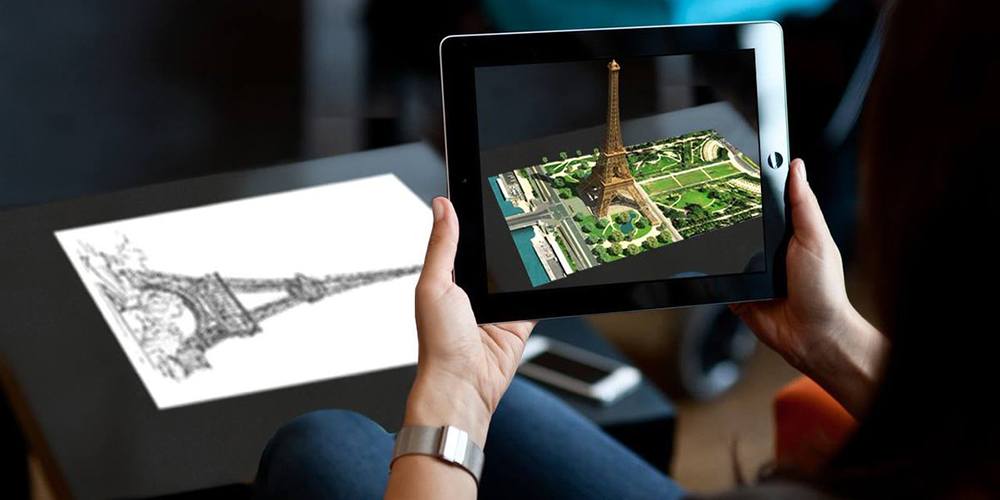
Hong Kong has developed an app for tourists that allows them to see what is no longer there without visiting a museum. To be specific, users scan modern street signs in at least 13 locations and get to learn about their historical role over time.
Hy-Way Heater - AR App from Program-Ace
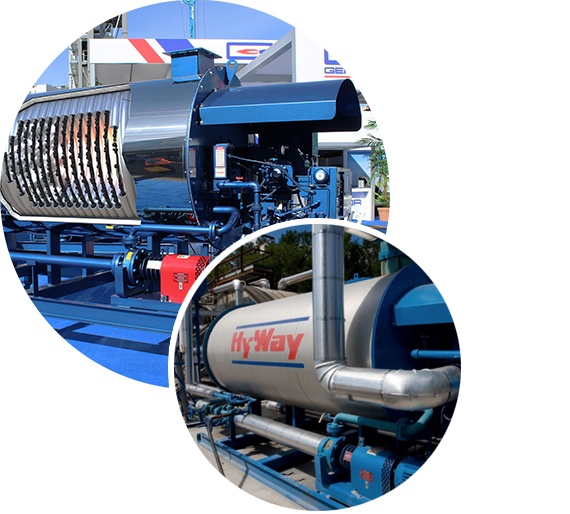
Program-Ace has developed the Hy-Way Heater AR Experience to demonstrate the complex function of a massive liquid heater. Users scan a printed QR code located on a very specific spot on the heater, and then get to virtually explore its configuration with a high degree of accuracy.
What is Markerless Augmented Reality?
Markerless augmented reality applications are characterized by their flexibility to function without the need for predefined images or markers. This attribute allows them to be utilized in a wide range of environments and settings. Unlike their marker-based counterparts, which require specific triggers to activate digital overlays, markerless AR uses advanced algorithms to detect environmental features such as surfaces, spaces, and object dimensions, enabling the seamless integration of digital content into the user's view.
Despite the absence of physical markers, the complexity and utility of markerless augmented reality should not be underestimated. The technology behind these apps involves sophisticated programming that allows digital content to be positioned and oriented accurately within the real world. These applications analyze the immediate surroundings through the device's camera, processing vast amounts of data to understand the context and scale of the environment before overlaying digital information.
The versatility of markerless AR makes it an ideal choice for a variety of applications, from interior design, where users can visualize furniture in their own home, to navigation systems that overlay directional arrows and street names onto the live camera feed. As one of the different types of AR, it represents a significant evolution in the field of augmented reality, offering more dynamic and spontaneous interactions with digital content.
Markerless systems are increasingly preferred in scenarios where users require instantaneous and context-aware augmented experiences, marking a significant advancement in the types of augmented reality available today. This progression underscores the expanding capabilities of augmented reality technology as it becomes more integrated into everyday tasks and settings.
When to use the markerless approach
The markerless approach in augmented reality is particularly advantageous when an application is expected to be used across diverse and potentially unpredictable conditions. This flexibility is essential for scenarios where it is impractical to require users to interact with specific markers, such as QR codes, to trigger AR content. For instance, in a retail setting where customers might want to visualize how clothes fit without the constraints of marker-based technology, markerless AR provides a seamless solution. By utilizing advanced algorithms, the app adjusts to the user's specific location and dimensions, collecting real-time data to customize the digital overlay of clothing on the user's image.
Moreover, markerless augmented reality is designed to maximize user accessibility, making it an excellent option for developers aiming to reach the broadest possible audience. By removing the need for physical markers, it simplifies the user's interaction with the technology, allowing a wider range of environments where augmented reality can be effectively deployed. This type of AR typically offers a balance of ease and functionality, delivering a satisfactory level of accuracy and precision suitable for the general public's use.
Furthermore, by embracing the types of augmented reality that do not depend on markers, developers can enhance the user experience by providing more intuitive and context-aware applications. These types of augmented reality systems are capable of delivering immersive experiences without the limitations associated with fixed markers, thereby supporting a more natural interaction between the digital content and the physical world. As augmented reality technology evolves, these capabilities become increasingly refined, expanding the potential applications and making augmented reality more accessible and enjoyable for users in various settings.
How to create a markerless app
Developing a markerless augmented reality app typically involves programming the application to identify flat surfaces and the boundaries of various spaces, such as rooms and hallways. By recognizing these physical parameters, the app can project digital objects onto the user's environment at angles and scales that mimic their real-world counterparts. This allows the objects to appear as though they occupy actual physical space, providing a realistic and immersive user experience.
Regarding complexity and functionality, markerless augmented reality often surpasses its marker-based counterparts. By incorporating advanced technologies such as machine learning, these apps can enhance their environmental understanding and adapt more effectively to low-visibility conditions. This capability enables a more robust and versatile application performance, ensuring that digital overlays maintain their precision and realism even in less-than-optimal visual settings.
Markerless augmented reality is widely adopted across different platforms, including mobile applications and WebAR systems. The flexibility of markerless AR makes it highly suitable for a variety of uses, from interior design simulations, where users can place furniture in a room to see how it looks and fits, to educational tools that provide interactive, real-world scale models of objects and phenomena.
As augmented reality technology evolves, the distinction between the types of augmented reality becomes more pronounced. Markerless systems continue to gain popularity due to their convenience and the depth of interaction they offer. These types of augmented reality are particularly appealing because they do not require any physical setup or specific conditions to function effectively, making them more accessible and easier to use for a broader audience.
Examples of markerless augmented reality
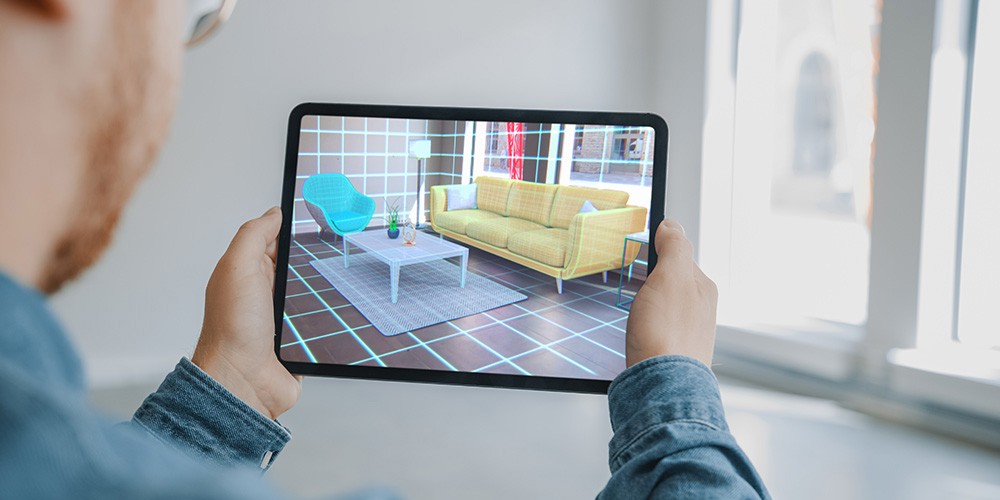
Stannah, a global elevator/escalator company, has built a markerless visualization app for prospective customers. It allows users in any home with multiple floors to see and understand how it will look if a stairlift from the said company is installed in their house.
A Silicon Valley startup is enabling sales through markerless AR. Their application lets customers preview a wide variety of products inside their homes, particularly on common surfaces like floors and desks. They make the most of advanced phone sensors to display the products in lifelike scale and position.
What is Location-Based Augmented Reality?
Location-based AR, also known as geo-based augmented reality, offers digital content that is contextually relevant to the user's geographic position. Unlike other types of augmented reality that rely on visual markers or physical cues within the environment, this type uses data from the user's GPS to provide location-specific experiences.
The sophisticated approach does not necessarily require the use of the camera for capturing visual markers but instead gathers information from the device’s GPS module, accelerometer, compass, and gyroscope. This data helps the application ascertain the user's precise location and orientation, enabling it to display appropriate augmented content that enhances the user’s interaction with their surroundings.
Furthermore, the effectiveness of location-based AR lies in its ability to seamlessly integrate digital overlays with the real world, depending on where the user is located. For example, in tourism, this form of augmented reality can enhance sightseeing experiences by providing tourists with interactive information about landmarks simply by reaching a particular location. Similarly, in gaming, it transforms real-world locations into game environments, enriching the user's gaming experience by linking it to actual geographical settings.
The applications of location-based augmented reality are diverse, reflecting its adaptability and the growing interest in contextual digital enhancements. This technology marks a significant advancement in the types of augmented reality available, as it does not bind the user to specific physical markers but offers a dynamic interaction based on their movement through various environments. This type of augmented reality is becoming increasingly popular, offering users a more immersive and personalized technology interaction as they navigate through the physical world.
When to use the location-based approach
Location-based augmented reality proves to be extremely beneficial for applications focusing on tourism, travel, and sports. Typically, these apps integrate data from extensive city and road maps to enhance the user's navigation and sightseeing experiences. Beyond urban environments, location-based AR also plays a crucial role in more remote or less mapped areas such as mountains, forests, and deserts. In such locales, where traditional camera-based augmented reality might fall short due to the lack of pre-recorded visual data, location-based AR taps into alternative sources of information.
For instance, in these expansive and often uncharted territories, the app can access and interpret geographical data like elevation profiles, types of terrain, and the characteristics of local flora and fauna. This information is then transformed into a detailed and interactive augmented reality map that users can view on their devices. Such maps are useful for orientation and enhance the outdoor experience by providing contextual information that might include trail guidance, points of interest, and even safety alerts about the natural environment.
Moreover, the use of location-based augmented reality in these settings underscores its versatility and adaptability, key attributes that make it one of the more dynamic types of augmented reality. As augmented reality technology continues to evolve, these applications demonstrate a growing capability to provide rich, location-specific content that enriches the user's interaction with their environment, regardless of how well-trodden or isolated it may be. The flexibility makes location-based AR a valuable tool in the repertoire of augmented reality types, suitable for a wide range of activities that require geographical awareness and enhanced situational context.
How to create a location-based app
Many developers favor this form of augmented reality due to its simplified approach, which does not necessitate the integration of intricate image recognition capabilities or the use of specific markers within the application. Instead of relying on visual cues, the application harnesses data directly from the device. This data includes the user's location, the orientation and elevation of the device, and the speed at which the user is moving. The app can adapt its functionality in real-time by processing this information to suit the user's immediate context.
Additionally, this type of augmented reality merges the collected device data with open-source information, such as detailed street maps or virtual tours of notable sites. This combination enriches the user's experience by providing a layer of digital interaction that feels intuitive and seamless. Users can explore a location with enhanced details that offer a deeper understanding and appreciation of the space around them.
This method is particularly appealing because it allows for a broad application of augmented reality without the technical complexities often associated with other types. By eliminating the need for physical markers, developers can create more versatile and accessible applications. This type of augmented reality, focusing on user-centric and location-specific data, supports a variety of uses, from urban navigation to virtual tourism, making it a popular choice among augmented reality types.
The flexibility and user-friendly nature of this approach not only facilitate wider adoption of augmented reality technologies but also broaden the scope of potential applications, making it a staple in the diverse ecosystem of augmented reality types.
Geo AR Examples:
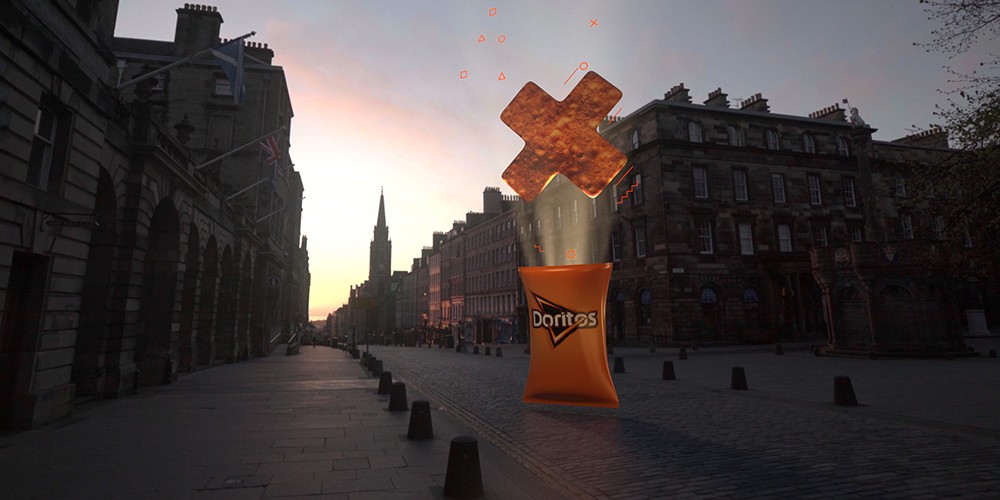
Doritos, the well-known global chip brand, conducted a unique marketing campaign with location-based AR. They gave users a custom map with Doritos bags dropped at various locations. After visiting these nearby locations, users could also go to a designated real-life location to pick up a reward for their efforts.
New York’s Museum of Modern Art featured a unique experience based on an augmented reality tracking system. After users downloaded the app and allowed it to access their location, they could see new and spectacular digital art pieces that were physically unavailable in the museum gallery.
What is Projection-Based Augmented Reality?
Projection-based AR is a unique form of immersive tech that does not require any smartphone or gadget. In fact, it doesn’t require any kind of screen. Instead, one or multiple projection devices form a 3D model with light. Most commonly, the 3D model is static (unmoving), but it is certainly possible to animate it as well. This approach is essentially what we think of when we imagine a hologram.
When to use projection-based AR
Because few consumers have the hardware needed to form these models of light, this type of solution is mostly used by businesses – for presentations, AR training, and development purposes. For example, the projections can be used as part of a marketing campaign or a pitch to investors to develop a new product. A detailed representation of a product or system can also help customers/employees learn about its structure and how it works.
How to create a projection-based experience
Projected 3D models are not formed through apps, so you will just need the spatial/design data and special hardware (projectors) to present them. The data for the 3D model can be collected through scanning or photographing a physical item or through custom design. Past that, you will spend much time calibrating the settings of the projector(s), making sure the model’s depth, edges, color, size, and other visual aspects are accurate.
Projected AR Examples:
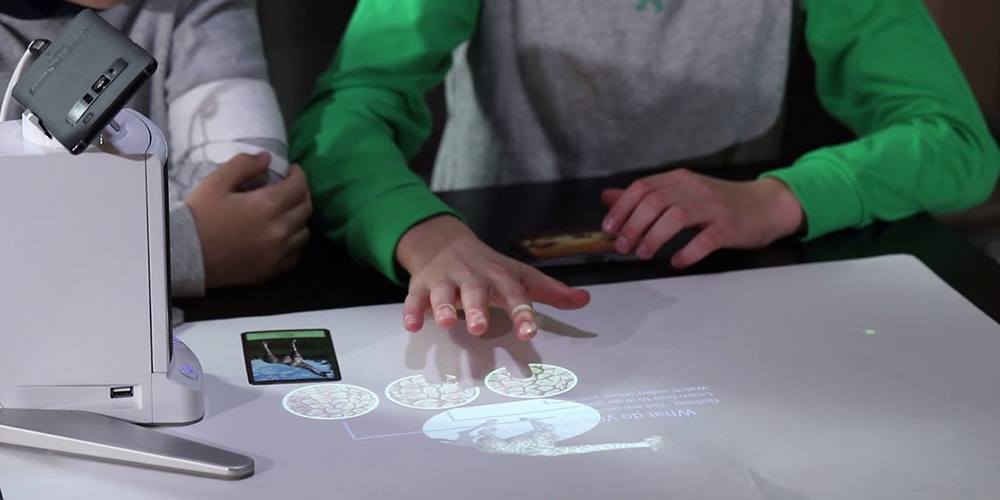
The prominent global airline Lufthansa is using projection-based AR to build and design VIP aircraft. For example, the technology projected the locations where T-Rails (metal beams) in the fuselage should be installed, significantly reducing the level of manual work required.
Nike (the worldwide shoe manufacturer) hosted a projection experience at its studio in London. This solution allowed shoppers and anyone interested to design their own model of Nike shoe and see it in full 3D spatial glory.
Comparing the Different Types of AR
With so much variety in augmented reality solutions, it can be difficult to choose the type that is best suited for your business. To make the process easier for you, we have made a side-by-side comparison of the options below:
Purpose
Marker-based AR
Precise visualizations tailored to one object or location
Markerless AR
Universal visualization with recognition based on environment
Location-based AR
Contextual content displayed based on user movements
Projection AR
Highly realistic presentation with no user interface or screen
Advantages
Marker-based AR
- Markers can be easily designed and implemented
- Tracking and visualization are very accurate
- Minimal actions are necessary from the user’s side
Markerless AR
- Usable in any location
- Unfettered range of motion
- Object recognition and tracking is often faster than the human eye can process
Location-based AR
- Contextual content can be provided all over the world
- No camera required
- Easiest tracking system to develop
Projection AR
- The most realistic depiction of a digital object
- Many users can see/experience it together
- Creates a strong emotional impression
Challenges of development
Marker-based AR
It is quite difficult to implement consistent tracking after the user turns their device away from the marker
Markerless AR
Creating a recognition system for reflective or transparent surfaces can be very complicated
Location-based AR
GPS is a strong drain on phone batteries, so app performance must be highly optimized
Projection AR
Each model takes a long time to develop and calibrate on projection devices
Primarily used in industries
Marker-based AR
Manufacturing, Energy, Education, Healthcare
Markerless AR
Retail, Construction, Interior Design, Real Estate
Location-based AR
Transportation, Hospitality, Travel, Recreation
Projection AR
Marketing, Entertainment, Education, Manufacturing
Please note that the table above is a general reference and does not even begin to cover the peculiarities of the 4 AR types. For example, if you do not see a particular industry or use case covered, this does not mean that the door is closed for it. The technology is very flexible in what and where it can be used, so the main requirements for development are imagination and a solid business case.
How to Build an AR Experience of Your Own
If you are new to the world of immersive tech, getting started with app development can be a long and difficult process. Most businesses that decide to implement such a solution lack the resources (time/specialists/experience) to do it in a timely and expert fashion, so they put their trust in a development partner.
Program-Ace is one of the leading companies in the field of AR/VR development with a focus on enterprises and companies operating in a wide variety of industries. We are the company behind the previously mentioned Hy-Way Heater AR application and a good number of other immersive projects.
We will be thrilled to help you with your AR project, even if it is highly complex and large in scope. Just contact us, and we will take the first step forward towards getting it done at an excellent level of quality!

